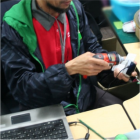In the battle of personal identity verification, biometrics have finally reigned supreme over passwords.
The reason is simple; biometrics can ensure greater security for personal information. It also provides customers with a more seamless experience in the digital environment of smartphones, tablets, sensors, and other devices.
It’s become clear that passwords are an untenable way for any online transaction and identity verification. This, however, is unsafe from the prying eyes and fingers of thieves and hackers, who can easily use digital signature patterns to break into people’s accounts, and steal sensitive personal information.
That’s not happened when using biometrics. By using physical or behavioral human characteristics to digitally identify a person to grant access to systems, devices or data, biometrics are harder to manipulate than passwords and have a high degree of authenticity.
Unlike keys and passwords, your personal traits are extremely difficult to lose or forget. They can also be very difficult to copy. For people on the move, biometric authentication is easier and safer than entering a complex password several times a day.
Fighting Identity Theft
Unlike passwords, biometrics is the only method that establishes a link between our physical and digital identities. This helps us prevent identity theft, enabling us to prove that a person accessing an account or device is really who he or she claims to be.
Stealing biometric data without the person’s knowledge, and then reproducing it in a useable form is not as easy as stealing a password and using it remotely.
Eliminate Large-Scale Data Hacking
While it’s relatively easy to access thousands of accounts with stolen passwords in just a few seconds, it’s much harder to hack biometric databases.
The possibility of any large-scale attack from hackers are eliminated as they can’t produce fakes for each stolen element. While the number of PIN codes is limited to the digits between 0000 and 9999, biometric data is unlimited.
Biometric systems
Biometric systems can seem complicated, but they all use the same three steps:
- Enrollment: The biometric system records basic information about you, like your name or an identification number. It then captures an image or recording of your specific trait.
- Storage: The systems analyze your trait and translate it into a code or graph. Some systems also record this data onto a smart card that you carry with you.
- Comparison: It compares the trait you present to the information on file. Then, it either accepts or rejects that you are who you claim to be.
There are three components of the systems:
- A sensor that detects the characteristic being used for identification.
- A computer that reads and stores the information.
- Software that analyzes the characteristic, translates it into a graph or code and performs the actual comparisons.
What is Biometrics Applications?
Biometrics, whether used on a PC, smartphone or tablet, is a viable alternative to passwords and other identifiers. It guarantees people’s identities to ensure the security of online operations and services:
- Secure payments: biometric bank cards, payment by selfie check or by fingerprint recognition, etc.
- Online authentication: filing tax statements, etc.
- Secure healthcare services: reliable patient identification and identity monitoring.
For Public Security
Biometrics facilitates investigations by law enforcement units. It has been used at borders for suspicious persons detection, or authorize access for persons who do not entail a risk.
Law enforcement has used biometrics devices for multi-biometric identification systems, including video analysis, ID checks, etc.
For passenger facilitation in airports, biometrics has smoothed the process of identification at borders, automated or accelerated control processes, etc.
By applying biometrics, organizations can create value for customers by giving users what they expect from digital security: the ease and convenience of doing business seamlessly in a safe environment.
To learn more about biometrics solutions, contact our customer service hotline today.






